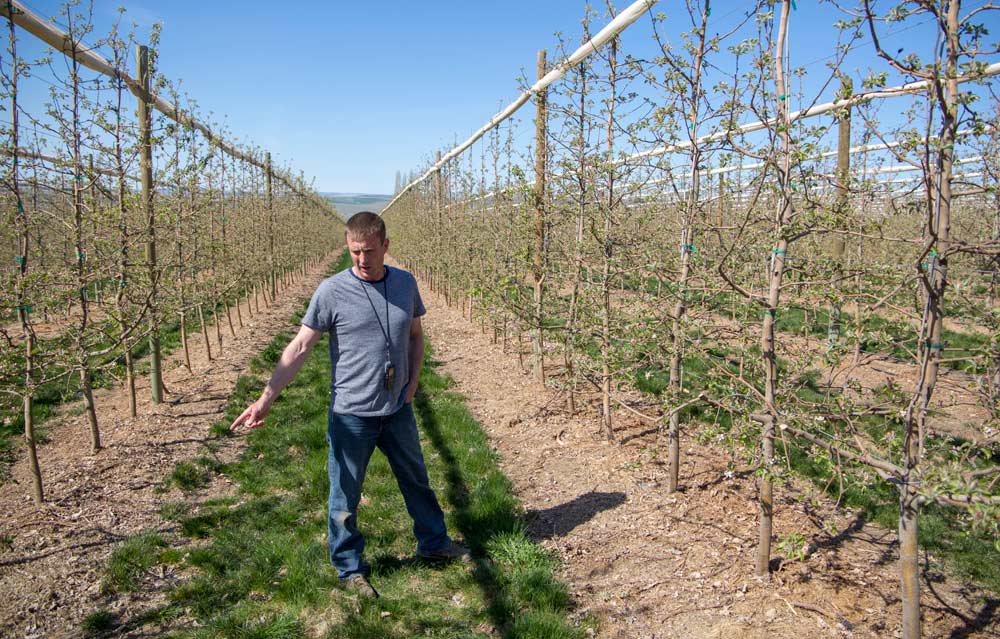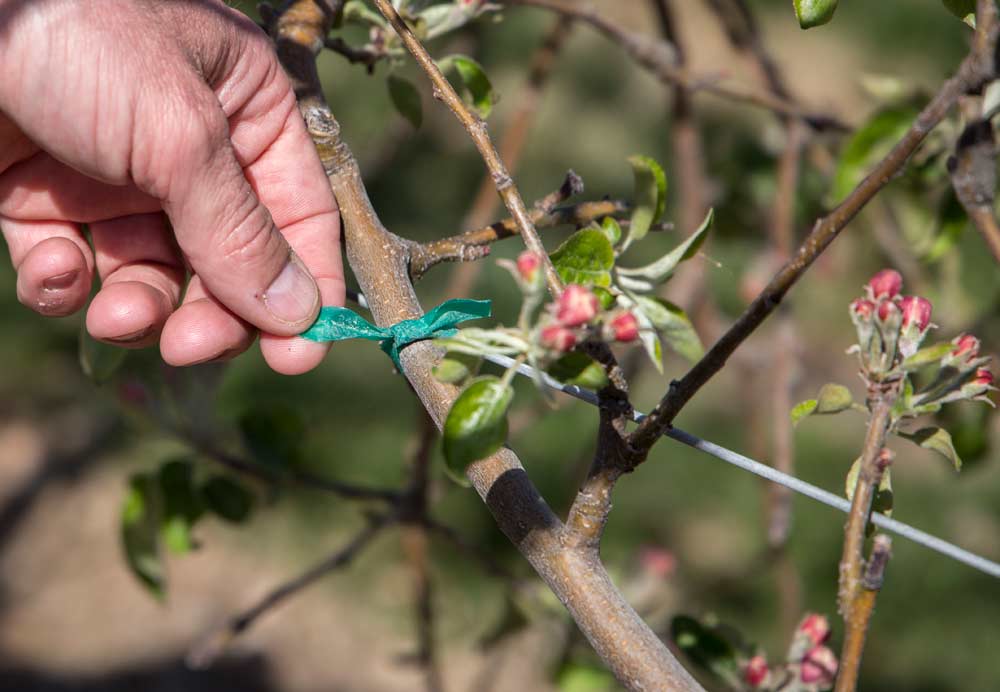
Amos Kukes shows off his Geneva 41 plantings Monday, April 23, 2018, in Quincy, Washington. He and nursery owners say good horticultural practices, such as timely trellising and careful handling, overcome the brittleness of the rootstock, prized for productivity and resistance to replant problems, fire blight and woolly apple aphid. (Ross Courtney/Good Fruit Grower)
Don’t let a little brittleness stop you from using Geneva 41 rootstocks.
Though not a unanimous endorsement, many growers and nursery owners say trellising, careful handling and a few other simple horticultural tricks can overcome the tendency of the replant tolerant roots to break.
“You have to be a little more careful with it,” said Tye Fleming, owner of Helios Nursery in Ephrata, Washington.
However, others contend it’s not worth the risk.
“Of all the rootstocks we’ve ever carried, it has the highest replacements and field loss I’ve ever seen (on a rootstock),” said Tom Callahan, director of sales of Adams County Nursery in Aspers, Pennsylvania.
Therein lies the question: to G.41 or not to G.41? Growers and nursery owners have mixed reviews.
The rootstock is prized for its productiveness and resistance to replant diseases, fire blight and woolly apple aphid. However, it has some drawbacks: It’s brittle in the graft union, the wood and the roots. Most nursery owners say it ranks among the highest in losses.
Fleming, other nursery managers and some growers contend that problem can be overcome by early trellising, careful digging and gentle handling. All rootstocks have “idiosyncrasies we have to learn how to deal with,” Fleming said.

Amos Kukes ties lower limbs of his Honeycrisp trees to a trellis wire, an important practice to implement as soon as possible when planting any variety on G.41. (Ross Courtney/Good Fruit Grower)
Amos Kukes, an orchard manager in Quincy, suggests simply handling them gently. His farm lost an estimated 1 percent of the roots when planting. “You’d see them out in the field where we threw them out,” he said.
Still, he calls G.41 his favorite rootstock for replant sites. He echoed the advice to start them on a trellis immediately, tying the limbs to the lower wire for support. “You don’t have to have every wire in either” at planting time, he said.
The growers need to just be more cautious, said Jim Adams, vice-president of Willow Drive Nursery in Ephrata, Washington. Even the act of pulling them out of the bins can cause breaks. He advised carrying new trees by the root, or better yet, right at the union, and not by the scion. And, once again, stake them or trellis them right away. The G.41 is the first rootstock he has trellised in the nursery in 20 years. “They’re too expensive to break,” he said.
Still, G.41 is the first rootstock to sell out at Willow Drive, he said.
At Wafler Nursery, in Wolcott, New York, G.41 is the second most popular rootstock, behind Budagovsky 9, in spite of its brittleness, said nursery manager Bill Pitts. Pitts and Wafler have been working with G.41 rootstocks for 20 years or more, hosting some of the original test plots.
“Most of my customers dealing with 41 have already had some failures,” he said.
The nursery recommends growers stake and trellis their new trees right away. Pitts also recommends patience, slowing down the growth of the tree to keep the caliper small and the graft union more malleable. It also will allow the roots and top to grow roughly at the same pace.
Callahan of Adams County Nursery had harsher words for G.41. He doesn’t like it and doesn’t mind saying so. “Some people think it’s political suicide to disparage a rootstock,” he said. “I’m just telling you the truth.”
The company contracts out most of its G.41 sales with West Coast partners because he would rather not take the risk.
Not only is it brittle, he said, it leads the scion to a more upright growth habit, and rabbits in the Eastern U.S. love it, just as they do Malling 27, a parent of G.41. “If rabbits like it, mice will like it, too,” Callahan said. He suggests using a tree guard and bait for mice in the fall.
For G.41 fans, he makes the usual recommendation about trellising early but also suggested either removing or cutting back to 1 inch all side limbs half the caliper of the central leader or thicker and cutting all other feathers in new trees back to 4 inches to remove bloom. This is important to compensate for extreme root loss, he said. Also, do not head the leader.
“Follow this advice, and the tree will start faster and the leader will get to the top of the system faster,” he said.
Also, watch out for adjusting tree height after planting, he said; if growers need to pull up a G.41 tree, they should grab it by the roots, not the scion.
Pete Van Well, president of Van Well Nursery in Wenatchee, Washington, said he and other nurseries are having higher success rates with G.41 through bench grafting and planting in the spring than budding in August.
He agreed with Fleming about the learning curve on G.41 and the series of Geneva apple rootstocks released in the past decades.
“In the scheme of rootstocks, when you talk about M.9 (Malling 9) being around since World War II, Geneva is pretty new,” he said. •

Geneva 41 rootstocks on Tuesday, April 24, 2018, at Helios Nursery in Quincy, Washington. (Ross Courtney/Good Fruit Grower)
G.41 tips
Here are a few tips for using Geneva 41 rootstocks echoed by growers and nursery managers.
—Trellis, or at least stake, right after planting.
—Carry new trees by the root or graft union, not by the scion.
—If adjusting tree height, dig a little extra and pull up by the root, not the scion.
—Gently separate new trees from each other when removing from the bin. The roots themselves break easily.
—Don’t push the tree. Grow slowly the first year to keep the union malleable.
—Like with any new trees in a high-density planting, remove or cut back to
1 inch all branches half the caliper of the central leader or bigger and cut feathers back to 4 inches.
—by Ross Courtney






Thanks for a very informative review of this ( G41) rootstock. I was much interested in getting some …but now not so much, as I don’t like being that finicky with trellising, since it is so brittle.!🙄